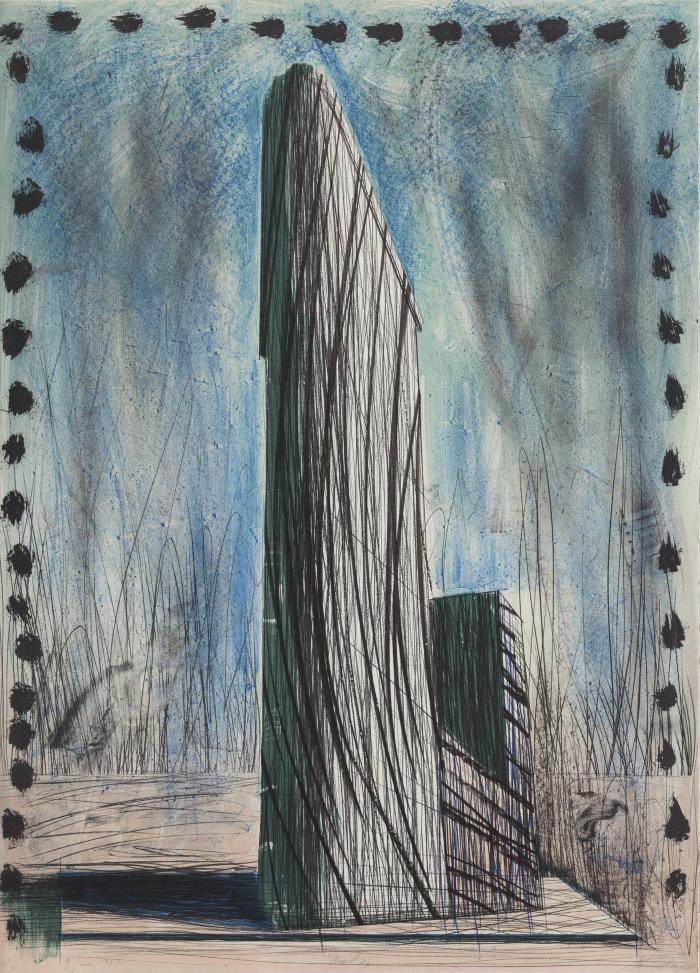
Buil II
Hideki Kimura
- 1989
- Offset Lithograph
- Image/sheet: 30 x 22"
- 60 prints in this edition
About the Print
“Straight, Simple, Easy & Free.” This is the motto of celebrated contemporary artist Hideki Kimura, whose stunning creations have led him to be dubbed the “rock star” painter from Kyoto. Under his brand, Ki Yan Studio, Hideki Kimura continues to produce stunning visual works of art. His dynamic art style is fresh and evocative, and it is a fascinating combination of his background in Japan’s early rock music scene and reverence for Japanese culture.
—From https://shop.japanobjects.com/pages/hideki-kimura, accessed 6-25-2021
The iconic Flatiron Building in Lower Manhattan was built on a triangular plot of land and assumed that shape to maximize the use of available space. In construction, the 90-degree angle is absolutely essential for stability—any deviation from it requires adjustments for balance and weight distribution. It also offers interesting design opportunities, as architects sometimes create problems or challenges intentionally as part of the design process. Resolving these self-created problems/challenges will, ultimately, produce a visually and structurally stronger design. In addition, architects will respond to the wishes of clients by providing attractive and innovative designs and construction dynamics using their creativity, knowledge of advanced mathematics, and new building materials and systems.
—From Brandywine Workshop and Archives records
About the Artist
Born in Kyoto, Japan, Hideki Kimura completed undergraduate and postgraduate degrees in oil painting at Kyoto City University of Arts (KCUA). He moved to the US in 1988, where he attended the University of Pennsylvania, Philadelphia. Kimura returned to Japan in 1995, where he worked as an associate professor at KCUA.
Kimura’s work has been exhibited internationally in solo and group exhibitions at institutions and juried events including the International Biennial Exhibition of Prints in Tokyo; British International Print Biennale in Bradford, United Kingdom; International Print Triennial in Krakow, Poland; and the Exhibition of Contemporary Japanese Prints in Ferrara, Italy.
His work is included in the collections of Japan’s National Museums of Modern Art in Tokyo, Kyoto, and Osaka; Museum of Contemporary Art, Tokyo; The British Museum and the Victoria and Albert Museum, London; National Museum in Warsaw, Poland; and the Philadelphia Museum of Art.
—From Brandywine Workshop and Archives records
Curriculum Connections
Suggested Topics for Algebra I and Geometry
Algebra I:
The resources provided can be used early on in an Algebra class to help students think in multiple dimen- sions. The artworks can be used to demonstrate illusions intended as a design element or to help students imagine space constructed or deconstructed from forms or shapes within a space. The ability to visualize concepts through art can make advanced math more accessible to students early on.
Geometry:
Some may want to use images in the Artura.org library to explore more complex uses of advanced math to create the illusions of space and solve spatial dynamic issues for three-dimensional works such as stand-alone sculpture and site-specific, public artworks. The laying of bricks or ceramic tiles is a skilled craft that can involve creativity and innovation in bricks or tiles are set and many available options in color, design, and texture are used. Sculptors such as Melvin Edwards, Richard Hunt, and John T. Scott have consistently used higher math concepts in the creation of large scale, space-defining public art.
Questions to Consider
- What are the different considerations between symmetry and asymmetry in relation to designing a structure or composing a work of art?
- What roles can rhythm, repetition, pattern, proportion, and scale play in an architect’s design and construction process? What roles can they plan in making a work of art?
- Other than the design of buildings, where else does one observe the use of the right angle in a creative way and for what purposes?
